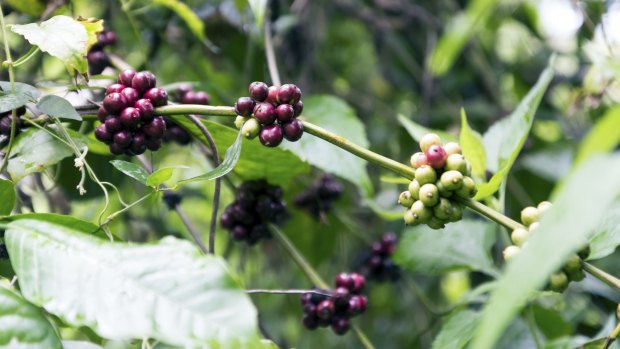This was published 6 years ago
Jackie French: Why I'm emotionally attached to my coffee pot
By Jackie French
It is almost time for the biennial migration of our coffee bush.
Every spring Bryan and Michael haul it and its pot outside so the predators can clean up the scale that for some reason adores our living room. It takes about a month for the scale eaters to discover the coffee bush is there. The leaves thicken up beautifully in the extra heat on the paving outside our back door, and the coffee berries that set on the white flowers indoors ripen nicely.

Each coffee flower produces a two-lobed fruit, the coffee berry. This is green at first, then red, then bright scarlet.
Hopefully just before the first big frost of winter they haul the coffee bush in again. It and its big blue pot sit in the sunny corner of the living room, extremely happy as long as I run my fingers over new shoots and the backs of the leaves to scrape off or squish the scale.
For a few years it was easy to haul in and out as it was only a metre high. Then came a few years when it stayed in the living room all year round, still bearing coffee berries, until last year's complications after surgery (mine, not its) meant the bush had a four-month break from aphid squishing.
It wasn't happy. Scale injects a toxin as well as sucking sap from the plant. Scale infestation means plants slowly pine, losing leaves and new shoots start withering. The bush looked miserable by the time they hauled it into the fresh air.
We could take a risk and leave it outside this winter. Plants do become more cold and frost hardy as they are exposed to cold. But pots are vulnerable, as they cool down faster than the garden soil. And I am emotionally attached to the coffee bush.
If you have a sunny window, I deeply recommend a potted coffee bush, not just so that you can pretend that one day you will be entirely self-sufficient in coffee. If you live in an area that has no more than light frosts (or a sheltered spot against a white, north-facing wall, say, in cooler areas) you can grow your own coffee – a hedge of them look superb, especially if carefully trimmed. Mail-order nurseries now offer a range of varieties if you'd like to see what both grows in your area and also tastes best for you.
Coffee bushes can grow to an enormous size, though not in a medium-sized pot. They are usually kept pruned, though, to about two to three metres, and can be kept much smaller if space is limited. The bushes have dark shiny leaves, with clusters of highly scented white flowers.
They need moist but well-drained soil, with plenty of organic matter and a good nitrogen/phosphorous balance to keep the bush producing heavily. A spot with broken light, say under taller trees, is excellent to start off your coffee bushes: they will be protected from both frost and strong light.
Each coffee flower produces a two-lobed fruit, the coffee berry. This is green at first, then red, then bright scarlet. At that stage they should be picked, or just admired – they really are extremely pretty.
There isn't room to explain how to turn the berry into a cup of coffee, but it is all quite possible in your kitchen. Google and you will find.
And if you are bored with the standard rubber tree or kentia palm in your office, you might even try a coffee club there, too – the bush kind. An indoor coffee hedge is a far more plant-friendly way to divide offices than screens.
This is the week to
- Plant garlic, lots of garlic, also peas, snow peas, sweet peas, broad beans and whatever annuals you want to bloom through winter, like pansies or primulas or Iceland poppies.
- Pick apples, eat apples, go to farmers' markets to buy fresh apples and, while fresh apples can be picked for 10 months of the year if you source the right varieties, March is the season for many of the best of them so eat and be thankful.
- Hunt out Golden Queen or other late peaches, the best for stewing, freezing, chutney and jam making as well as fresh eating, though quite different from the delicate flesh of early peaches.
- Resist harvesting any watermelon unless the stem has yellowed or withered – the difference between a sort of ripe and a very ripe melon is delicious versus drool worthy.
- Enjoy the early blooming nerines and plant a great many of their bulbs now if you don't have any.
- Watch the slow, subtle progress of autumn, the deeper longer shadows, flowers with richer colours that last longer in the gentler sun and the blush of pomegranates.
Botanic Gardens Native Plant sale
The Growing Friends of the Canberra Botanic Garden are having a native plant sale on Saturday, April 7 from 8.30am-11am at the Banks Building car park. All plants are sourced from the gardens and proceeds go to the gardens' upkeep. Plant list and further information available a week before the sale at: http://anbg.gov.au/friends